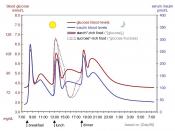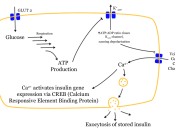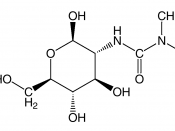Diabetes Mellitus is a common disorder of metabolism in which the amount of glucose or sugar in the blood is too high, suffocating the body's cells, and damaging the sufferer's health. The words "diabetes mellitus" comes from the Greek words meaning "a fountain of sugar" (9).
Diabetes Mellitus is a complex subject, but one factor is key to the whole issue - insulin. Insulin is a hormone - a substance produced within one part of the body that has its effects in other parts of the body, which it reaches through the bloodstream. It's produced solely by specialized (beta) cells within the pancreas gland. The stimulus to the pancreas that causes it to release insulin is the circulating level of glucose in the blood (8). After a meal, for example, glucose will rise both because it may be present in food and as a result of being produced by conversion from other foodstuffs by other chemical reactions within the body.
This rise in glucose will stimulate the release of insulin, which then has several immediate effects. First, insulin stimulates the liver and muscle cells to take up glucose and become more active in making glycogen. Second, insulin reduces the liver's output of glucose. These actions reduce the level of blood glucose. Third, insulin activates muscle cells to manufacture protein and fourth, insulin stimulates fatty tissue to take up circulating fat molecules (fatty acids) from the blood. These actions build up more energy reserves in the body. Absence of insulin effectively causes the reverse to happen. Blood glucose continues to rise after a meal as there are no correcting influences and the storage of glucose within cells is impaired. Liver output of glucose (from glycogen) carries on at the same rate and circulating fatty acids are not shifted into fat tissues...


